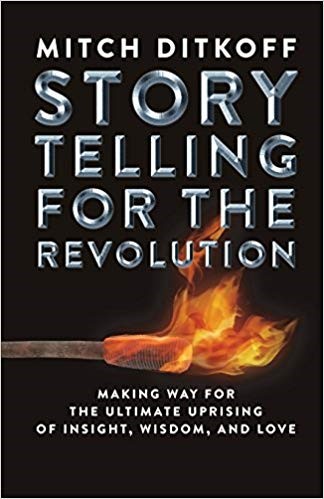Helping Children Truly Understand the Moral of a Story
As a so-called "thought leader"in the field of storytelling and an author of two books on the topic, Storytelling at Work and Storytelling for the Revolution, I tend to think that I am quite knowledgeable about the matter. And while this may true in some ways, a few months ago I had a chance to experience how little I really understand.
My epiphany was not sparked by newly released research or reading someone else's book on the subject. No. My epiphany was sparked by 26 second grade students attending Al Siraat College, an Australian K-12 school, in the Islamic tradition, just outside of Melbourne.

As part of my series of residencies at Al Siraat, I'd been invited by one of the school's most progressive teachers, Ms. Najma, to teach her second grade class how to write and tell stories.
Ms. Najma's invitation had come as quite a surprise to me, especially since I had never taught a second grade class before, my usual students being upwardly mobile movers and shakers from a wide variety of corporations. Not a single student in Ms. Najma's class has a corner office, reserved parking space, or high blood pressure. What they did have, however, was a noticeable twinkle in their eye and a whole lot of curiosity about what it took to become a writer and teller of tales.
Up for the challenge, I spent the night before figuring out what a three-week storytelling curriculum for 8-year olds might look like. I googled. I noodled. I made lists. But in the end, it became clear that this was going to be an organic process and that all I needed was a game plan for Class #1. The rest of the classes would take care of themselves.
Class #1 was a gas. Apparently, my quirky sense of humor and willingness to begin the class with a juggling demonstration was more than enough to win the kids over. In just a few minutes I had them in the palm of my hand, or, if not the palm, then at least somewhere near my elbow. They loved it. I loved it. And the aforementioned Ms. Najma loved it.
Not wanting to overload them, I kept things super-simple, asking them to tell me why stories mattered, why stories were so popular, and what their favorite fairy tales were. Then I gave them a brief tutorial about the five elements of a story. Boom! Victory! They got it!
A bow, a wave of the hand, and a promise to see them on Wednesday and I was out the door.
Class #2 was not only gas. It was also a hoot. I read one of my own stories and after it was told, we deconstructed it together -- teaching, from the "inside out".
Inspired as they were, I gave each of them a post-it pad and one instruction -- to think of a story they wanted to write and, as soon as they thought of it, to write the title of their story on a sticky note.
Somehow, for an 8-year old, having a title for their story is extremely beneficial. Like having a handle for a cup, it provides leverage and a sense of power -- something all of us can use just a little more of these days.
Titles written, I asked each student, one by one, to read their title aloud. Wow! 26 stories were begininng to take shape, 26 products of their imagination would soon be written and read!
Class #3 was the day of my unexpected epiphany -- a lesson I will never forget. Technically speaking, I was the teacher. But in reality, I was the student and the students were the teachers -- even if they had no idea that what I was about to experience would be a life-changing moment for me, as a teacher, writer, father, and storyteller.
For most second graders and, indeed, for most of the rest of humanity, stories are a kind of entertainment, a pleasant way to pass the time or be distracted from the "real world". The real purpose of storytelling, however is not to distract, but to communicate a meaningful, memorable, message -- a timeless piece of wisdom that will evoke, in the reader or listener, increased awareness -- what most of us have come to know as "the moral of the story."
The seed. The teaching. The takeaway.
This is the topic I wanted to introduce to Ms. Najma's class of second-graders -- how to increase the odds of the stories they wrote having a meaningful message at it's core.
At first, upon bringing up the topic, the students looked at me blankly, as if I was introducing them to geometry. Taking my cue from their confusion, I floated out the titles of a few fairy tales and asked what they thought the morals or messages embedded in those tales might be. Bingo! They got it. The concept clicked. Game on! So I gave each of them another post-it pad and asked them to write down the key message of their story.

Two minutes. That's all the time it took them. Only 90 seconds longer than it takes a kid to eat a cookie.
"Fantastic! That's great! Good job! Now, please stand up, come to the front of the room, and post the morals of your stories on the board."
Twenty-six students stood. 26 students found their way to the front of the room. 26 students posted, thrilled that their story's message was now, somehow, official. Then, at my instruction, they sat down on the floor so I could call on each of them, one by one, to read their morals aloud for everyone to hear.
I removed the first sticky note from the white board and read it aloud.
"Don't be rude," I announced to the class. "OK," I added. "That's the first moral of someone's story: 'Don't be rude'. Now let's see what the second one is all about."
I pulled the second one off the wall.
"Don't be mean." And then I pulled a third, "Don't go outside." And a fourth, "Never talk to strangers." And a fifth, "Don't interrupt".
A definable, disturbing pattern was emerging. Every single moral was a negative one. Every message began with either "Don't" or "Never". One by one, I pulled each sticky note off the wall and read them to the class. And one by one, I began to understand what the 26 second graders in Ms. Najma's class really thought stories were -- cautionary tales. What not to do. What shouldn't be done. Behaviors that were either not permissible, dangerous, or bad.
Oops!
I could feel a great sadness welling up inside me. But at the same time, I could also feel a great opportunity, as I, again, read the first moral of the story aloud: "Don't be rude."
"Can anyone tell me another way the writer of this story could say the same thing -- maybe in a way that offered the reader a positive message?"
"Be kind?" one of the students offered.
"Yes. 'Be kind' is another way the moral of that story can be expressed. And do you know why delivering the message in this way is something you might want to try?"
"Because it feels better?" replied one of the kids. "Because it's not so scary?" said another.
"Exactly! You got it!" I responded. "And also because framing the moral or message of your story in a positive way gives the reader or listener something they can do -- a positive behavior they can try."

Class over, I made a bee line to the office of Mufti Aasim, the school's spiritual director and the Head of Islamic studies to tell him what I had just witnessed.
His response was immediate.
He put his head in his hands, closed his eyes, and shook his head from side to side, lamenting about the way in which society, schools, and parents have misused stories for far too long. Then, he asked if he could read me a few passages from the Quran which represented the essence of that holy book and how the true teachings of Islam focus on the bright side of what's possible -- what we can do, not what we can't.
"Would you teach the next class?" I asked him. "I want you to experience this first-hand."
And so he did with great love, patience, clarity, and wisdom -- reading three stories from the Quran and asking the students to identify the real message embedded in each of the stories he told. And when, they framed those messages in negative ways, as they had been accustomed to doing, Mufti Aasim gently worked with them to help them frame the messages of those stories in positive ways -- what they could do instead of what they couldn't -- choices of thought and language that helped those 8-year old students more deeply understand the timeless wisdom embedded in the Quran and how each of them could live their lives in harmony with that wisdom.
A WORD TO THE WISE: If you are a teacher, parent, grandparent, big brother, or big sister and find yourself reading or telling a story to a child, please be mindful of the way in which you frame the moral of the story. Like the second graders in Ms. Najma's class, it's all too easy to default to the cautionary tale zone -- to use story as a way to control behavior -- to warn, instill fear, or make wrong. This is not the high path. This is the low road.
The real purpose of stories is to increase the odds of the reader or listener becoming discerning, making wise choices, trusting their higher self, tuning into wisdom, and understanding what it means to be a fully conscious human being.
Using stories like a stick to control behavior is not the way to go. It's a misuse of the sacredness of story and a misuse of your opportunity to help a still-forming human being tap into their higher self. And while it is true that many stories provide a context for children to make distinctions between "good and bad", the real opportunity we have as teachers or parents is to help the young ones think for themselves and make wise choices, not just roboticly follow rules, warnings, or the instructions of their elders.
Cookie photo: Fischer Twins
Al Siraat College
Mitch Ditkoff
Storytelling for the Revolution
13 brief storytelling videos
Post a comment
Thanks for signing in, . Now you can comment. (sign out)
(If you haven't left a comment here before, you may need to be approved by the site owner before your comment will appear. Until then, it won't appear on the entry. Thanks for waiting.)







 If you like this blog, you might also like Mitch's other two blogs:
If you like this blog, you might also like Mitch's other two blogs: 